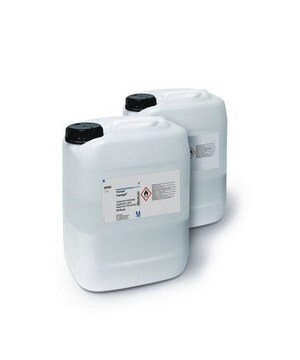1.02330
Cellulose microcrystalline
for thin-layer chromatography
Sinônimo(s):
Cellulose microcrystalline
About This Item
Produtos recomendados
Materiais
cellulose matrix
plastic support
Nível de qualidade
Formulário
microcrystalline
temperatura de autoignição
232 °C
potência
>5000 mg/kg LD50, oral (Rat)
>2000 mg/kg LD50, skin (Rabbit)
Características
binder Organic Polymer
fluorescent indicator: no
embalagem
pkg of 500 g
técnica(s)
thin layer chromatography (TLC): suitable
tamanho de partícula
5-40 μm
tamanho de poro
60 Å medium pore diameter
pH
5-7.5 (20 °C, 100 g/L in H2O, slurry)
temperatura de transição
flash point 260 °C
densidade
1.5 g/cm3 at 20 °C
densidade volumétrica
70‑400 kg/m3
temperatura de armazenamento
2-30°C
cadeia de caracteres SMILES
O1[C@H](C(C(C(C1CO)O)O)O)O[C@@H]2C(OC(C(C2O)O)O)CO
InChI
1S/C12H22O11/c13-1-3-5(15)6(16)9(19)12(22-3)23-10-4(2-14)21-11(20)8(18)7(10)17/h3-20H,1-2H2/t3?,4?,5?,6?,7?,8?,9?,10-,11?,12+/m1/s1
chave InChI
GUBGYTABKSRVRQ-WFVLMXAXSA-N
Descrição geral
Aplicação
- Study of the influence of cellulose derivatives on physical and analytical attributes of a drug product belonging to BCS class II.: This research explored the impact of cellulose microcrystalline on the physical properties and analytical performance of a class II drug product. The findings demonstrated the role of cellulose microcrystalline in enhancing the stability and dissolution rate of the drug, contributing to improved bioavailability (Domoslawska et al., 2018).
- Application of ethyl cellulose, microcrystalline cellulose and octadecanol for wax based floating solid dispersion pellets.: The study investigated the use of microcrystalline cellulose in the formulation of wax-based floating pellets. The results highlighted its effectiveness in controlling the release profile and enhancing the floating properties of the drug delivery system (Yan et al., 2016).
- Modelling of porosity and waterfronts in cellulosic pellets for understanding drug release behavior.: This paper presented a model for analyzing the porosity and water penetration in cellulosic pellets, providing insights into the drug release mechanisms. The study emphasized the crucial role of microcrystalline cellulose in modulating drug release profiles (Gomez-Carracedo et al., 2010).
- Fast dissolving films made of maltodextrins.: The research explored the incorporation of microcrystalline cellulose in fast-dissolving films, demonstrating its impact on film integrity and dissolution rates. The findings support the use of microcrystalline cellulose in enhancing the performance of oral thin films (Cilurzo et al., 2008).
- Compressibility of floating pellets with verapamil hydrochloride coated with dispersion Kollicoat SR 30 D.: This study evaluated the compressibility and mechanical properties of floating pellets containing microcrystalline cellulose, showing its role in maintaining pellet integrity and controlled drug release (Sawicki & Lunio, 2005).
Nota de análise
d 50 (laser diffraction, size distribution): 10 - 30 µm
d 90 (Laser diffraction, size distribution): 30 - 60 µm
produto relacionado
Código de classe de armazenamento
11 - Combustible Solids
Classe de risco de água (WGK)
WGK 1
Ponto de fulgor (°F)
Not applicable
Ponto de fulgor (°C)
Not applicable
Certificados de análise (COA)
Busque Certificados de análise (COA) digitando o Número do Lote do produto. Os números de lote e remessa podem ser encontrados no rótulo de um produto após a palavra “Lot” ou “Batch”.
Já possui este produto?
Encontre a documentação dos produtos que você adquiriu recentemente na biblioteca de documentos.
Os clientes também visualizaram
Nossa equipe de cientistas tem experiência em todas as áreas de pesquisa, incluindo Life Sciences, ciência de materiais, síntese química, cromatografia, química analítica e muitas outras.
Entre em contato com a assistência técnica


